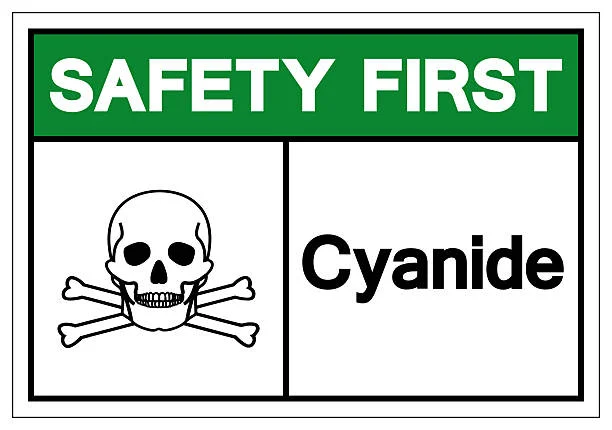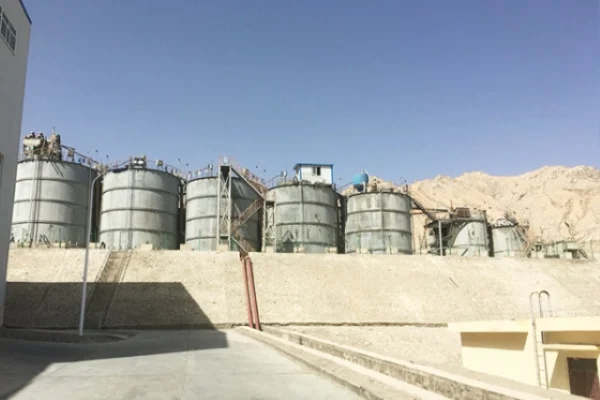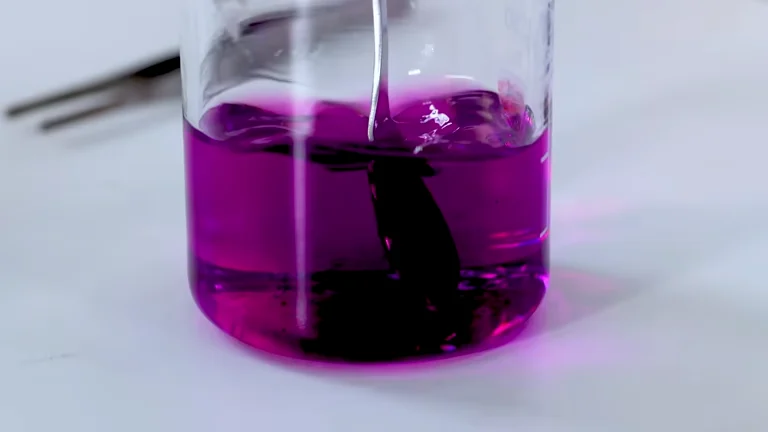Introduction
Cyanidation is a widely used and effective method for gold extraction from gold - bearing ores, especially in the case of copper - bearing gold ores. It is based on the ability of cyanide ions to form stable complexes with gold, allowing for the dissolution of gold from the ore matrix. The fundamental chemical reaction in the cyanidation process for gold is 4Au + 8NaCN+O_2 + 2H_2O=4Na[Au(CN)_2]+4NaOH. This process has been the cornerstone of the gold mining industry for over a century due to its relatively high efficiency and well - understood technology.
However, when dealing with copper - bearing gold ores, the presence of copper minerals poses significant challenges. Common copper minerals associated with gold, such as chalcopyrite (CuFeS_2), chalcocite (Cu_2S), malachite (Cu_2(OH)_2CO_3), and azurite (Cu_3(OH)_2(CO_3)_2), are quite reactive in cyanide solutions. For instance, in a cyanide - containing medium, chalcocite can react as follows: Cu_2S + 4NaCN=2Na[Cu(CN)_2]+Na_2S. These reactions lead to the consumption of a large amount of cyanide. The excessive consumption of cyanide not only increases the production cost but also has environmental implications due to the toxicity of cyanide.
Moreover, the dissolution of copper can interfere with the subsequent processes of gold recovery. High levels of copper in the cyanide solution can reduce the efficiency of gold - cyanide complex formation, thus decreasing the gold leaching rate. This is because copper competes with gold for cyanide ions and oxygen in the solution, disrupting the chemical equilibrium required for efficient gold dissolution. In some cases, the presence of copper can also cause problems in downstream processes such as zinc - cementation or carbon - in - pulp (CIP) for gold recovery, leading to lower gold recovery rates and poor product quality.
Therefore, finding effective reagents to inhibit the leaching of copper during the cyanidation of copper - bearing gold ores is of great significance. Such reagents can help to optimize the cyanidation process, reduce cyanide consumption, and improve the overall efficiency of gold extraction, making the mining operation more economically viable and environmentally friendly. In the following sections, we will explore various reagents that have been studied and used for this purpose.
The Leaching Characteristics of Copper in Cyanide Solutions
In cyanide solutions, copper minerals associated with gold exhibit distinct leaching behaviors. Common primary copper minerals such as chalcopyrite (CuFeS_2) and chalcocite (Cu_2S), along with malachite (Cu_2(OH)_2CO_3), azurite (Cu_3(OH)_2(CO_3)_2), bornite (Cu_5FeS_4), cuprite (Cu_2O), and native copper, are relatively soluble.
These copper minerals can be leached at room temperature (25^{\circ}C). The leaching rate of copper varies widely, ranging from 5 - 10% to over 90%. For example, malachite and azurite, which are copper - carbonate minerals, are quite reactive in cyanide solutions. The chemical reaction of malachite with cyanide can be expressed as Cu_2(OH)_2CO_3+4NaCN + H_2O = 2Na[Cu(CN)_2]+Na_2CO_3 + 2NaOH. This shows that under the action of cyanide, the copper in malachite can be effectively dissolved.
When dealing with high - copper gold concentrates, the leaching process during cyanidation has some "clinical" symptoms. The consumption of cyanide becomes extremely high. Generally, for different copper minerals, the dissolution of 1 gram of copper requires the consumption of 2.3 - 3.4 grams of Sodium cyanide. At the same time, the dissolution of copper also consumes oxygen in the solution. For instance, in the leaching process of chalcocite, the reaction 2Cu_2S+8NaCN + O_2+2H_2O = 4Na[Cu(CN)_2]+2Na_2S + 4NaOH occurs, which not only consumes a large amount of cyanide but also a significant amount of oxygen.
Moreover, the leaching effect becomes relatively poor. High levels of copper in the cyanide solution can reduce the efficiency of gold - cyanide complex formation. Copper competes with gold for cyanide ions and oxygen in the solution. As a result, the chemical equilibrium required for efficient gold dissolution is disrupted. This leads to a decrease in the gold leaching rate and can also cause problems in subsequent gold - recovery processes such as zinc - cementation or carbon - in - pulp (CIP), ultimately resulting in lower gold - recovery rates and reduced product quality.
Common Reagents for Inhibiting Copper Leaching
Lead Salts
Lead salts are often used as reagents to inhibit copper leaching in the cyanidation of copper - bearing gold ores. The commonly used lead salts include lead nitrate (Pb(NO_3)_2), lead acetate (C_4H_6O_4Pb\cdot3H_2O), and lead oxide (PbO).
Take lead acetate as an example. Research has shown that adding lead acetate before cyanide leaching can effectively inhibit the leaching of copper, enhance the leaching of gold and silver, and reduce the consumption of Sodium Cyanide. For a certain gold concentrate with a copper content of 4.92%, when 150 g/t of lead acetate is directly added before leaching, under the conditions of a grinding fineness of -0.037 mm particle size accounting for 95%, a leaching time of 48 h, a sodium cyanide concentration of 0.5%, a pH of 12, and a pulp concentration of 40%, the gold grade in the leaching residue can be reduced to 1.20 g/t, the gold leaching rate reaches 97.55%, the silver recovery rate is 60.28%, and the sodium cyanide consumption is 14.37 kg/t. This clearly demonstrates the positive effect of lead acetate in this process.
The inhibitory mechanism of lead salts may be related to the formation of insoluble compounds. For example, lead can react with sulfur - containing substances in the ore to form insoluble lead sulfide. This reaction reduces the amount of sulfur - containing substances that can react with copper minerals, thereby inhibiting the dissolution of copper minerals. In addition, lead salts may also affect the surface properties of copper minerals, reducing their reactivity in the cyanide solution.
Chelating Agents (e.g., Citric Acid)
Chelating agents, such as citric acid, can also play a role in inhibiting copper leaching during cyanidation. The chelating - type leaching - aid agents like citric acid work through a unique mechanism. Citric acid contains carboxyl and hydroxyl groups, which can chelate with harmful ions such as Cu^{2 +}, Zn^{2+}, Fe^{2+}, and Fe^{3+} in the pulp to form stable chelates.
For instance, the carboxyl group in citric acid can coordinate with metal ions through the lone - pair electrons of oxygen atoms, forming a ring - like structure. By chelating these metal ions, citric acid can eliminate their negative impacts on the cyanidation leaching process, such as reducing their consumption of oxygen in the solution. Moreover, citric acid can inhibit the dissolution of gangue minerals such as calcium - and magnesium - containing minerals. It can interact with the surface of these gangue minerals, changing their surface charge and hydrophilic - hydrophobic properties, making them more difficult to dissolve in the cyanide solution. This inhibition of gangue minerals can also improve the "effective active oxygen" in the pulp. When the gangue minerals are less likely to dissolve, they consume less oxygen, and more oxygen is available for the cyanidation of gold, which is beneficial to the leaching of gold. In general, the addition of citric acid can help to create a more favorable chemical environment for the cyanidation of gold, reducing the interference of other metal ions and improving the efficiency of gold extraction.
Others (Brief Introduction)
In addition to the above - mentioned reagents, controlling the concentration of cyanide ions can also be an effective way to weaken the dissolution of copper. When the concentration of cyanide ions is properly controlled within a certain range, the reaction rate of copper minerals with cyanide can be reduced. For example, for some gold ores with a relatively high content of easily - soluble copper minerals, by keeping the concentration of free CN^ - ions at a relatively low level (such as 0.05% - 0.10%), the dissolution rate of copper minerals can be significantly slowed down, while the dissolution rate of gold minerals is still relatively high, so that the cyanide mainly acts on the dissolution of gold minerals.
Another method is to use the ammonia - cyanide system. In the ammonia - cyanide system, ammonia can form complexes with copper ions, which can inhibit the leaching of copper to a certain extent. However, due to the high volatility of ammonia, it is difficult to maintain a stable concentration in the industrial production process, which limits its large - scale industrial application. Although this method has the advantage of reducing copper leaching, the challenges in practical operation and cost - effectiveness need to be further addressed.
Factors Affecting the Effect of Reagents
The effectiveness of reagents used to inhibit copper leaching during the cyanidation of copper - bearing gold ores is influenced by several factors, which are crucial to understand for optimizing the cyanidation process.
Ore Properties
Type of Copper Minerals
Different copper minerals have distinct reactivities in cyanide solutions. For example, copper - carbonate minerals such as malachite (Cu_2(OH)_2CO_3) and azurite (Cu_3(OH)_2(CO_3)_2) are relatively more reactive compared to some primary sulfide copper minerals like chalcopyrite (CuFeS_2). Malachite readily reacts with cyanide according to the reaction Cu_2(OH)_2CO_3+4NaCN + H_2O = 2Na[Cu(CN)_2]+Na_2CO_3 + 2NaOH. This high reactivity means that when using reagents to inhibit copper leaching, a higher dosage might be required for ores rich in such reactive copper minerals.
In contrast, chalcopyrite has a more complex structure and requires more energy and specific reaction conditions to dissolve in cyanide solutions. However, under certain conditions, it can still contribute to significant cyanide consumption. Understanding the dominant copper - mineral type in the ore is the first step in determining the appropriate reagent and its dosage.
Content of Copper Minerals
The higher the copper - mineral content in the ore, the greater the potential for copper leaching and the corresponding consumption of cyanide. For instance, in a gold - bearing ore with a copper content of 5%, the amount of cyanide consumed by copper - leaching reactions will be much higher than in an ore with a copper content of 1%. As a result, the reagent needed to inhibit copper leaching must be proportionally adjusted. A higher - copper - content ore may require a larger amount of lead salts or chelating agents to effectively suppress copper dissolution. Research has shown that for every 1% increase in the easily - soluble copper content in the ore, the consumption of a lead - salt - based inhibitor may need to be increased by 10 - 20 g/t to maintain the same level of copper - leaching inhibition.
Process Conditions
Cyanide Concentration
The concentration of cyanide in the solution plays a dual - role in copper leaching and the effectiveness of inhibitors. When the cyanide concentration is low, the rate of copper - leaching reactions is reduced. For example, if the free - cyanide concentration (CN^ -) is maintained at 0.05% - 0.10%, the dissolution rate of copper minerals can be significantly slowed down. However, if the cyanide concentration is too low, the leaching rate of gold may also be negatively affected.
When using reagents like lead salts, the optimal cyanide concentration for their effectiveness can vary. In some cases, a slightly higher cyanide concentration (around 0.15% - 0.20%) may be required to ensure that the lead - salt inhibitor can form insoluble compounds with sulfur - containing substances in the ore, effectively inhibiting copper leaching. But if the cyanide concentration is too high, it can promote the dissolution of copper minerals despite the presence of inhibitors.
pH Value
The pH of the cyanide solution is critical for both copper leaching and the action of inhibitors. In general, the cyanidation process is carried out in an alkaline medium, usually with a pH in the range of 10 - 11. At this pH range, the stability of the cyanide ion is maintained, and the hydrolysis of cyanide is minimized.
For chelating agents such as citric acid, the pH of the solution affects their chelating ability. Citric acid contains carboxyl and hydroxyl groups that chelate with metal ions. In an alkaline medium, the dissociation of these functional groups is promoted, enhancing their chelating ability with copper ions. However, if the pH is too high (above 12), it can cause side - reactions that may reduce the effectiveness of the chelating agent. For example, in a highly alkaline solution, some metal - chelate complexes may break down, releasing the chelated copper ions back into the solution.
Leaching Time
The leaching time can influence the degree of copper leaching and the performance of inhibitors. As the leaching time increases, more copper may dissolve if not effectively inhibited. For example, in a short - term leaching process (less than 12 hours), the amount of copper leached may be relatively small, and the inhibitor can more easily control the copper - leaching rate. But if the leaching time is extended to 48 hours or more, the cumulative effect of copper - leaching reactions may become more significant.
In the case of lead - salt inhibitors, a longer leaching time may require a higher initial dosage of the inhibitor. This is because over time, the lead - containing insoluble compounds formed may gradually be consumed or their effectiveness may decline due to the continuous presence of reactive substances in the cyanide solution. So, the leaching time needs to be carefully considered when determining the amount and type of reagent to use for copper - leaching inhibition.
Case Studies and Practical Applications
Case 1: Application of Lead Salts in a Gold Mine in South Africa
A gold mine in South Africa was processing a copper - bearing gold ore with a copper content of approximately 3%. Before using lead salts as an inhibitor, the cyanidation process faced several challenges. The consumption of cyanide was extremely high, reaching up to 15 kg/t of ore, and the gold leaching rate was only around 80%. The high copper content in the ore led to significant copper dissolution during cyanidation, which not only consumed a large amount of cyanide but also interfered with the gold - leaching process.
After adding lead nitrate (Pb(NO_3)_2) at a dosage of 200 g/t of ore, remarkable changes were observed. The cyanide consumption was reduced to 8 kg/t of ore, a decrease of about 47%. The gold leaching rate increased to 90%. The economic benefits were significant. Considering the price of cyanide and the value of the additional gold recovered, the mine saved approximately $50 per ton of ore processed. From an environmental perspective, the reduced cyanide consumption meant less environmental risk associated with cyanide leakage and disposal. The amount of cyanide - containing waste was also reduced, which was beneficial for the local ecological environment.
Case 2: Chelating Agent (Citric Acid) Application in a Gold Mine in Australia
In an Australian gold mine, the ore contained a significant amount of copper minerals, mainly chalcopyrite and some copper - carbonate minerals. The initial cyanidation process without using a chelating agent had a gold leaching rate of 75% and a copper leaching rate of 30%. The high copper leaching rate led to a high consumption of cyanide, about 12 kg/t of ore.
When citric acid was added to the cyanidation process at a dosage of 1 kg/t of ore, the situation improved. The copper leaching rate was reduced to 10%, and the gold leaching rate increased to 85%. The consumption of cyanide decreased to 6 kg/t of ore. Economically, the cost of citric acid addition was relatively low compared to the savings in cyanide consumption and the increased gold recovery. The mine estimated that it could increase its annual profit by about $300,000. Environmentally, the reduced copper leaching meant less copper - containing wastewater, which was easier to treat and had less impact on water resources in the surrounding area.
Case 3: Application of a New Inhibitor (MZY) in a Chinese Gold Mine
A gold mine in China was dealing with a refractory copper - bearing gold ore. The traditional cyanidation process had a gold leaching rate of only 70% and a high copper leaching rate, which caused a large amount of cyanide consumption. After adding a new inhibitor MZY at a certain dosage, along with optimized process conditions including the addition of 18 kg/t of lime and 1.2 kg/t of sodium cyanide, the gold leaching rate reached 83% - 84%, and the copper leaching rate was reduced to 4% - 5%.
This new process not only improved the gold - leaching efficiency but also significantly reduced the cyanide consumption. The economic benefits were two - fold: the increased gold recovery added more value to the production, and the reduced cyanide consumption saved costs. In terms of environmental protection, the lower cyanide consumption and less copper - containing waste reduced the environmental burden, making the mining operation more sustainable. These case studies clearly demonstrate the practical value of using reagents to inhibit copper leaching in the cyanidation of copper - bearing gold ores, both in terms of economic benefits and environmental protection.
Conclusion
In the cyanidation process of copper - bearing gold ores, the leaching of copper not only leads to high consumption of cyanide but also has a negative impact on the leaching rate of gold and subsequent gold - recovery processes. Therefore, the use of reagents to inhibit copper leaching is of great significance.
Lead salts, such as lead nitrate, lead acetate, and lead oxide, can effectively inhibit copper leaching by forming insoluble compounds with sulfur - containing substances in the ore or changing the surface properties of copper minerals. Chelating agents like citric acid can chelate with copper ions and other harmful metal ions, reducing their negative impacts on the cyanidation process. Additionally, controlling cyanide concentration and using the ammonia - cyanide system can also play a role in weakening copper dissolution to a certain extent.
The effectiveness of these reagents is influenced by various factors. Ore properties, including the type and content of copper minerals, determine the reactivity of copper in the ore and thus affect the amount of reagent required. Process conditions such as cyanide concentration, pH value, and leaching time also have a significant impact on the performance of reagents. For example, an appropriate cyanide concentration and pH value can ensure the stability of the cyanide solution and the effectiveness of the reagent, while the leaching time can affect the cumulative effect of copper - leaching reactions.
Through case studies, we have seen the practical application value of these reagents. In South Africa, the use of lead nitrate in a gold mine reduced cyanide consumption and increased the gold leaching rate, bringing significant economic benefits and environmental advantages. In Australia, the addition of citric acid in a gold mine effectively reduced copper leaching and cyanide consumption while increasing the gold leaching rate, which was beneficial for both economic and environmental aspects. In a Chinese gold mine, the use of a new inhibitor MZY, along with optimized process conditions, improved the gold - leaching efficiency and reduced the copper - leaching rate, achieving good economic and environmental results.
In general, when dealing with the cyanidation of copper - bearing gold ores, it is necessary to comprehensively consider the characteristics of the ore and the requirements of the process, and select the appropriate reagent and operating conditions. Future research can focus on further exploring more efficient and environmentally friendly reagents, as well as optimizing the combination of reagents and process parameters to achieve more efficient, economical, and environmentally sustainable gold - extraction processes.
- Random Content
- Hot content
- Hot review content
- OCCUPATIONAL HEALTH & SAFETYMANAGEMENT SYSTEM CERTIFICATE
- T-610 collector Salicyl oxime acid derivative Content 3.5%
- Oxalic acid for mining 99.6%
- Magneto Electric Detonator(Anti stray current)
- Calcium Peroxide 60% Assay Yellowish Tablet
- Potassium Permanganate – Industrial Grade
- Sodium Peroxide
- 1Discounted Sodium Cyanide (CAS: 143-33-9) for Mining - High Quality & Competitive Pricing
- 2China's New Regulations on Sodium Cyanide Exports and Guidance for International Buyers
- 3Sodium Cyanide 98% CAS 143-33-9 gold dressing agent Essential for Mining and Chemical Industries
- 4International Cyanide(Sodium cyanide) Management Code - Gold Mine Acceptance Standards
- 5China factory Sulfuric Acid 98%
- 6Anhydrous Oxalic acid 99.6% Industrial Grade
- 7Oxalic acid for mining 99.6%
- 1Sodium Cyanide 98% CAS 143-33-9 gold dressing agent Essential for Mining and Chemical Industries
- 2High Quality 99% Purity of Cyanuric chloride ISO 9001:2005 REACH Verified Producer
- 3Zinc chloride ZnCl2 for High Molecular Weight Polymers Initiator
- 4High Purity · Stable Performance · Higher Recovery — sodium cyanide for modern gold leaching
- 5High Quality Sodium Ferrocyanide / Sodium Hexacyanoferr
- 6Gold Ore Dressing Agent Safe Gold Extracting Agent Replace Sodium Cyanide
- 7Sodium Cyanide 98%+ CAS 143-33-9











Online message consultation
Add comment: